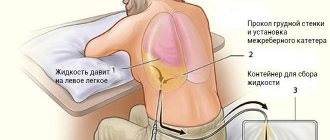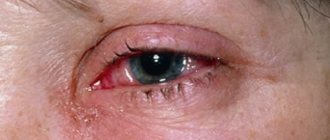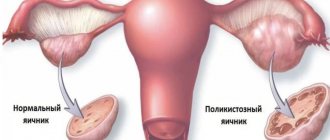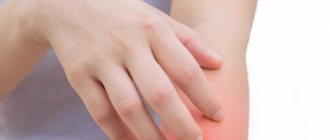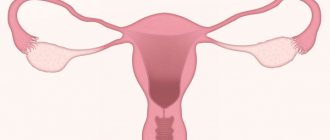Inflammation of the ovaries is a fairly common gynecological problem associated mainly with infection. It is one of the most relevant in clinical practice. The disease often becomes chronic, causes constant pain, negatively affects a woman’s menstrual, sexual, and reproductive function, and worsens her general well-being and emotional and mental state. Timely correct diagnosis and earlier initiation of treatment are of great practical importance.
Inflammation of the ovaries - what is it?
In the medical community, ovarian disease that develops as a result of inflammation is given the name “oophoritis.” If it is combined with inflammation of the fallopian tubes (also fallopian tubes, oviducts), then the term “salpingoophoritis” is used - this is how inflammation of the appendages is designated. In ICD-10 they are included in the section “Inflammatory diseases of the pelvic organs” and form a separate category “Salpingitis and oophoritis”, which is assigned code N70. Oophoritis can be unilateral or bilateral, when both glands are affected at once.
How to treat inflammation of the appendages: methods of folk and traditional medicine
Therapy is aimed at destroying the infection, restoring tissues affected by the disease and relieving pain. Inflammation of the appendages in women is treated not only with antibiotics, but also with drugs that support the immune system.
Drug therapy
Medicines are selected taking into account the individual characteristics of the patient and the presence of allergies. The following antibiotics are usually prescribed:
- Gentamicin;
- Claforan;
- Cephobid;
- Cefazolin;
- Ciprofloxacin;
- Doxycycline;
- Ofloxacin;
- Lincomycin.
For effective treatment, specialists use the complex use of the above remedies.
In addition to antibiotics, medications that have an anti-inflammatory effect are prescribed:
- Diflucan;
- Ibuprofen;
- Orphtofen.
To treat inflammation of the appendages in women, antihistamines are used, which reduce the risk of allergic reactions. Popular products in this category are Zodak, Zyrtec, Erius.
Surgery may be required at the initial stage of the disease. They resort to surgery in the following cases:
- adhesions in the pelvic organs;
- formation of a purulent cavity;
- loss of patency of the fallopian tube.
Therapy in the above cases is carried out in a hospital setting. It is impossible to cope with the disease at home.
Treatment of inflammation of the appendages in women with “grandmother’s recipes”
Traditional medicine helps stop the development of inflammation and the spread of infection. But they are not able to cure the patient, since only antibiotics can kill pathogenic microorganisms.
The following recipes are used in the treatment of adnexitis:
- For treatment, a decoction of a mixture of roots is used - Chernobyl, elecampane, peony, buckthorn and burnet. Two tablespoons filled with half a liter of hot water is enough. The broth is boiled over low heat for about half an hour, cooled and filtered for the same amount of time. Take half a glass 3-4 times a day. To improve the taste of the healing drink, honey is added. This bee product helps strengthen the immune system and gives the body strength to fight infection.
- They take a medicinal plant such as boron uterus and grind its dried leaves. A tablespoon of medicinal herb is poured with boiling water, one glass is enough. Leave to infuse, filter after two hours. The resulting decoction is taken in a third of a glass. It is recommended to consume 30 minutes before meals three times a day. The duration of the course is one month. After completing therapy with a decoction of boron uterus, it is recommended to drink an infusion of Yakut field grass for two months. To prepare the drink, add a tablespoon of dried herb to a glass of boiling water. Infuse and filter after four hours. A single serving is one teaspoon. The decoction is taken 3-4 times a day.
- Dried, pre-crushed flowers of coltsfoot, centaury and sweet clover are taken in equal proportions. Add a glass of boiling water to the resulting mixture and leave to infuse. After an hour, filter the broth using gauze. The cooled medicine is taken half a glass twice a day. Treatment with this method involves abstaining from sexual activity for the full course.
Pathogenesis
As an independent disease, oophoritis is extremely rare; it often develops as a secondary form caused by previous infection and the development of inflammatory processes in neighboring structures. The rarity of isolated inflammation of the ovaries is explained by the fact that the ovaries themselves are reliably protected by a dense protein membrane. Since the pelvic organs are compactly located and are a functional whole, there is a high probability of penetration (spread) of infection. It enters through the bloodstream, lymph from anatomically distant organs, from the infected intestines, lungs, genitourinary system, abdominal cavity, but more often there is an ascending route of infection - from the vagina, through the cervix, fallopian tubes.
Complications
In men, chlamydia causes inflammation of the epididymis (epididymitis), and in women it causes cervical disease, inflammation of the epididymis, and tubal infertility. During pregnancy, chlamydia can cause serious pathology of the fetus. It also leads to Reiter's disease (severe damage to the eyes and joints).
Monitoring the results of treatment for chlamydia, as well as other hidden STIs, should be carried out no earlier than 3 weeks after stopping medication. Symptoms may persist for several weeks or even months after successful treatment. As for resuming sexual activity, this is possible only after a follow-up examination of two partners.
Ureaplasmosis
Ureaplasmas are very small microorganisms that do not have and do not need their own cell membrane. This feature allows them to penetrate the cells of the host body, so very often they are not visible to the protective cells of the immune system. Consequently, ureaplasma can exist in the human body for more than 10 years. Note that ureaplasmosis is more common among women than among men.
Ureaplasmas received this name because of their ability to break down urea - ureolysis. That is why ureaplasmosis is a urinary infection; without urea, ureaplasma cannot survive. Very often, ureaplasmosis is associated with diseases of the urinary system, chronic cystitis, urethritis and pyelonephritis.
Ureaplasma is usually transmitted sexually, but it is also possible for a child to become infected during childbirth. The incubation period is approximately 1 month. The further development of the disease depends on the body’s immunity, the presence or absence of other vaginal diseases, etc.
In most cases there are no symptoms. Sometimes patients may complain of more abundant discharge than usual, a burning sensation when urinating, discomfort in the genital area and intermittent nagging pain in the lower back and lower abdomen.
Ureaplasma and pregnancy
Ureaplasma can lead to a destructive process in the appendages and uterus, thereby contributing to the development of complications that can lead to pathologies during pregnancy. That is why during this period it is imperative to get tested for this infection, and if it is confirmed, then undergo treatment.
Ureaplasma does not cause malformations in the fetus. In most cases, infection of the baby occurs during childbirth during the passage of the fetus through the infected birth canal. In addition, ureaplasmosis can cause miscarriage, premature birth, threatened miscarriage and endometritis (one of the postpartum complications).
Treatment during pregnancy is most often carried out at 18-20 weeks.
Treatment of ureaplasmosis
Treatment of this disease must be comprehensive and long-term. First of all, antibacterial drugs are prescribed, but taking antibiotics alone is not enough, since ureaplasma can easily adapt to the effects of antibiotics during treatment. Also used in treatment are drugs that increase general and local immunity; antifungal drugs, since antibiotics can cause thrush. The drug complex also includes drugs that can protect the intestines from the effects of antibiotics.
As for the need to treat a partner if he does not have an infection, this is a controversial opinion. This issue must be resolved by the attending physician and the partners themselves.
During pregnancy, the choice of drugs is limited. Only those drugs that are approved during this period can be used. Antibiotics include Vilprafen, Rovamycin, and Erythromycin.
Causes
Depending on the etiology of inflammation of the ovaries, they are divided into 2 groups:
- Specific processes - occur against the background of tuberculosis, mycoplasmosis, venereal disease (most often it is gonorrhea, genital herpes, trichomoniasis, chlamydia, and their combinations are also found).
- Nonspecific inflammation - caused by the penetration of opportunistic organisms, septic diseases, appendicitis. The main culprits: Escherichia coli, staphylo-, strepto- or pneumococci, enterococci, microorganisms of the genus Candida, clostridia, etc.
Predisposing factors for the development of oophoritis include childbirth, abortion, increased sexual activity, intrauterine contraception, and other interventions on the uterus.
The list of factors that provoke exacerbation of existing inflammation includes:
- general hypothermia of the body, swimming in cold water;
- inadequate or insufficient nutrition;
- prolonged stress;
- severe fatigue;
- weakening of the immune system.
Symptoms of ovarian inflammation
There are acute, subacute inflammation and chronic recurrent inflammation. In the acute course, the clinical picture is most pronounced, the patient is concerned about:
- severe pain in the depths of the pelvis, often radiating to the lower back;
- urination disorder;
- tense stomach, painful touch;
- spotting or purulent discharge (not in all cases);
- general phenomena - nausea, flatulence, fever, weakness, headache.
In the subacute phase, symptoms subside. Chronic oophoritis manifests itself:
- aching pain, aggravated by tension, during menstruation;
- pain radiating along the branches of the nerve;
- heavy or scanty periods, cycle failure;
- sexual desire disorder;
- painful sexual intercourse.
Gardnerellosis
The disease is not an STD. It is caused by gardnerella vaginalis, and, in fact, gardnerella is a manifestation of vaginal dysbiosis. That is, this is not inflammation in the vagina. That is why this disease is also called bacterial vaginosis.
Unlike other infections, with gardnerellosis the symptoms are pronounced and specific. Symptoms include heavy, thin vaginal discharge that is white or yellowish in color and has a very unpleasant odor, similar to rotten fish. This odor may become stronger during and after menstruation, as well as after sexual intercourse. This disease causes discomfort and burning in the external genital area.
During a gynecological examination, an experienced doctor will be able to immediately make a diagnosis, since the discharge has a slightly foamy characteristic appearance. In some cases, there may be no symptoms, so gardnerella can only be detected during an examination.
Gardnerella is located directly in the vagina. This infection most often does not penetrate further, therefore there are no symptoms such as, for example, pain in the lower abdomen.
Gardnerella and pregnancy
Gardnerella can cause a lot of trouble during pregnancy. It is possible, although very rare, that intrauterine infection may occur. Gardnerella can also cause inflammation of the uterus after childbirth or abortion. That is why bacterial vaginosis during pregnancy must be treated immediately when it is detected.
Gardnerella usually appears in a simple smear on the flora. The PCR diagnostic method is also used to identify them.
Treatment
Treatment is carried out in 2 stages. First, the infection is destroyed, and then the microflora in the vagina is restored.
At the 1st stage, drugs such as flagyl, fasigin, clindamycin, trichopolum are used.
The 2nd stage is longer, it can last 1 month or even more. Here you need to be patient, because... If the microflora is not restored, the disease will return again. Sexual activity during the treatment period is possible, but only if the partners use a condom.
In men, gardnerella “takes root” and does not develop, so treatment of sexual partners is not required.
Diagnosis
Recognizing oophoritis is a complex process, because Its manifestations are similar to many diseases. To establish the transition of inflammation to the ovaries, the gynecologist:
- Interviews the patient - interested in past illnesses, birth history, presence of abortions, symptoms, duration of course.
- Conducts an examination - palpation, manipulation with a mirror.
- Refers for laboratory testing - analysis of vaginal secretions, blood, urine, urethral smear, bacterial culture.
- Uses instrumental methods - hysterosalpingography, ultrasound OMT, fallopian tubes (USGSS).
- He resorts to additional methods - tuberculin diagnostics, PCR analysis, ELISA, laparoscopy.
Operations for chronic adnexitis
The chronic form of adnexitis without treatment is accompanied by suppuration. With advanced abscesses of the appendages, pills and injections will no longer help, so gynecologists recommend surgery. During intervention, the abscesses are opened and washed.
Now such operations are performed in a minimally invasive way - through laparoscopy. The essence of the technique is the possibility of performing all abdominal manipulations through several tiny holes in the anterior abdominal wall. Mini-instruments and video equipment are inserted into these punctures, making laparoscopy one of the safest surgical techniques.
Treatment
Severe forms are treated in a hospital. Therapy is conservative, long-term. The course is selected individually. The range of measures taken usually includes:
- drug therapy - antibiotics, anti-inflammatory drugs, immunomodulators, vitamins, eubiotics;
- hot douching, ichthyol suppositories, Longidaza;
- physiotherapy – mud, diathermy, ultraviolet irradiation, inductothermy, massage.
Indications for surgery include pain, purulent inflammation, adhesions, and peritonitis.
Features of therapeutic therapy for inflammatory diseases
The treatment regimen is determined by the doctor after examining the patient and identifying the causes, nature and severity of the inflammatory process; it can be conservative or surgical.
Treatment of inflammation of a bacterial nature includes taking antibiotics with bactericidal and bacteriostatic action, drugs to restore the beneficial microflora of the mucous membranes. To treat fungal infections, antifungal agents of various spectrums of action are used.
Treatment of inflammation caused by STIs is carried out with targeted drugs after determining the source of infection. In the treatment of viral inflammation, antiviral drugs are used, as well as drugs to strengthen the immune system. Anti-inflammatory creams and ointments, suppositories, suppositories for external use are also used. If there are symptoms of intoxication, drugs to reduce fever, antihistamines, painkillers, etc. are used.
When the first symptoms of inflammation appear, you must seek qualified help. Due to the fact that some inflammatory processes occur without visible symptoms, it is necessary to undergo scheduled preventive examinations 1-2 times a year.
Diagnosis and treatment of any inflammatory pathologies of the female genital organs are carried out by multidisciplinary gynecological specialists. A modern diagnostic laboratory is available to patients, which performs all types of laboratory tests, as well as expert-level diagnostic equipment.


